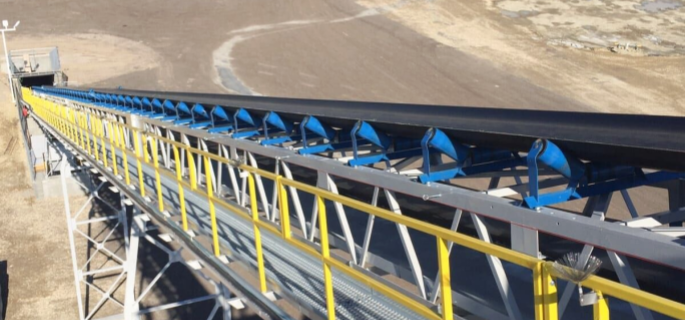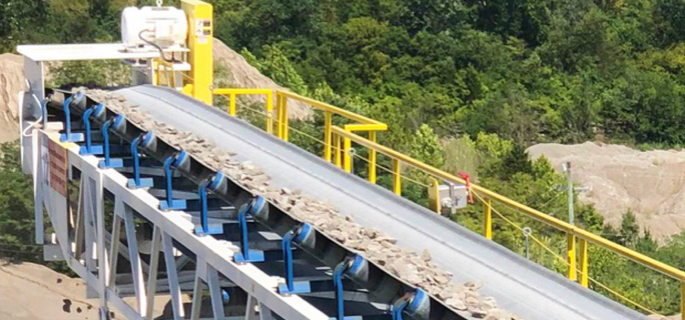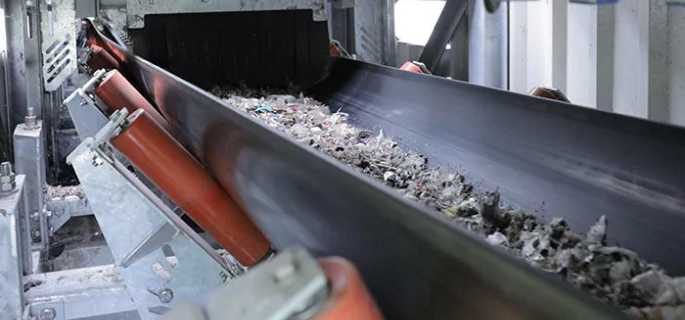How to Calculate Belt Conveyor System
Understanding how to calculate belt conveyor system parameters is crucial for the design, operation, and maintenance of these critical pieces of equipment.Basic calculate belt conveyor system ensures your conveyor design is accurate and efficient, preventing excessive system demands. In this introduction, we’ll explore the foundational concepts behind belt conveyor systems and highlight why precise calculations are not just beneficial but essential. Accurate calculations ensure operational efficiency, enhance safety, and prevent costly downtime and repairs. By the end of this section, you’ll gain an insight into how integral these calculations are to achieving a well-functioning conveyor system. This knowledge is key to optimizing the performance and longevity of conveyor belts across various industries.
How to Calculate Belt Conveyor System Using Conveyor Belt Calculators
Conveyor belt calculators are indispensable tools in the engineering and maintenance of conveyor systems. These calculators simplify complex calculations that are crucial for designing and optimizing the operation of belt conveyors. When you calculate belt conveyor system parameters using these calculators, you gain quick and reliable estimates of vital factors such as belt tension and load capacity.These tools typically require input data such as the conveyor’s length, width, and the load it carries. From there, they compute the necessary power, belt tension, and other essential metrics that influence the conveyor’s efficiency and safety. Using a conveyor belt calculator ensures that these calculations are both accurate and consistent, facilitating better planning and decision-making.
Calculating a belt conveyor system involves several key parameters and considerations. Conveyor belt calculators can simplify this process by providing an easy way to input these parameters and receive the necessary calculations. Here’s a step-by-step guide on how to use these calculators:
Step 1: Gather Necessary Information
Before using a conveyor belt calculator, collect the following data:
- Belt Length: The total length of the conveyor belt (usually in meters or feet).
- Belt Speed: The speed at which the belt moves (usually in meters per second or feet per minute).
- Load per Unit Length: The load that the belt will carry per unit length (usually in kilograms per meter or pounds per foot).
- Incline Angle: If the conveyor is inclined, the angle of the incline (in degrees).
- Drive Pulley Diameter: The diameter of the drive pulley (in meters or inches).
- Motor Power: The power of the motor driving the belt (usually in kilowatts or horsepower).
Step 2: Use the Conveyor Belt Calculator
There are various types of conveyor belt calculators available online, each with slightly different functionalities. Here are some common parameters you might need to input:
Conveyor Capacity:
- Formula: Q = A × v × ρ )
- Q: Conveyor capacity (m³/hr)
- A: Cross-sectional area of the load on the belt (m²)
- v: Belt speed (m/s)
- ρ: Density of the material (kg/m³)
Belt Tension:
- Formula: ( T = P/v )
- T: Tension (N)
- P: Power (W)
- v: Belt speed (m/s)
Belt Power:
- Formula: ( P = Q × H × 9.81 )
- P: Power (W)
- Q: Conveyor capacity (kg/s)
- H: Height (m)
- 9.81: Gravity (m/s²)
Motor Power:
- Formula: P = ( T × v )/η
- P: Motor power (W)
- T: Belt tension (N)
- v: Belt speed (m/s)
- η: Efficiency of the drive system
Step 3: Input the Data
Input the collected data into the respective fields of the conveyor belt calculator. The calculator will then process these inputs to provide the necessary outputs, such as:
- Required belt tension
- Required motor power
- Conveyor capacity
- Speed and load limits
Step 4: Analyze the Results
Once you have the results, analyze them to ensure they meet your system requirements. Adjust the parameters if necessary to optimize performance.
Example Calculation
For illustration, let’s assume we have the following parameters:
- Belt length: 50 meters
- Belt speed: 1.5 meters per second
- Load per unit length: 20 kilograms per meter
- Incline angle: 10 degrees
- Drive pulley diameter: 0.5 meters
- Motor power: 15 kilowatts
Using these parameters in a typical online conveyor belt calculator, you would:
- Input the belt length, speed, load per unit length, incline angle, and drive pulley diameter.
- The calculator would compute the required belt tension, conveyor capacity, and motor power based on the formulas provided.
Conveyor belt calculators are powerful tools that simplify the design and calculation process for belt conveyor systems. By accurately inputting the necessary parameters, you can ensure your conveyor system is designed for optimal performance and efficiency.

How to Calculate Conveyor Belt Pull And Required Power
Calculating the conveyor belt pull and the required power involves several steps and considerations. Here’s a step-by-step guide to help you:
Step 1: Calculate Belt Tension
The total belt tension (T) is calculated as the sum of the tension required to move the empty belt (Te), the tension required to move the load horizontally (Tl), and the tension required to lift the load (Th).
Empty Belt Tension (Te)
[ Te = Fr × L ]
Where:
- ( Fr ) = Friction factor (depends on belt type and condition)
- ( L ) = Length of conveyor (m)
Horizontal Load Tension (Tl)
[ Tl = Ml × g × L ]
Where:
- ( Ml ) = Mass of the load per meter (kg/m)
- ( g ) = Acceleration due to gravity (9.81 m/s(^2))
Lift Load Tension (Th)
[ Th = Ml × g × H ]
Where:
- ( H ) = Height of the lift (m)
Step 2: Calculate Total Belt Tension
[ T = Te + Tl + Th ]
Step 3: Calculate Belt Pull
The belt pull (P) is the force required to move the belt and load and is equal to the total tension (T).
Step 4: Calculate Required Power
The required power (P) can be calculated using the belt pull and the belt speed.
[ P = T × V ]
Where:
- ( V ) = Belt speed (m/s)
To convert this to kilowatts (kW), use:
[ P{kW} = P/1000 ]
Considerations
- These calculations assume a straight and level conveyor. Curved or inclined conveyors may require additional considerations.
- The friction factor (Fr) can vary based on the type and condition of the belt and should be adjusted accordingly.
- Ensure safety factors are applied based on the specific application and industry standards.

How to Calculate Belt Conveyor System Motor Power
Calculating the motor power for a belt conveyor system involves several key parameters and formulas. Here’s a detailed step-by-step guide to help you through the process:
Step 1: Gather Required Information
- Conveyor Length (L): The total length of the conveyor.
- Load per Unit Length (m): The weight of the material per unit length.
- Belt Speed (v): The speed at which the belt moves.
- Incline Angle (θ): The angle of the conveyor incline.
- Friction Factor (f): The friction factor of the conveyor belt and material.
- Drive Pulley Diameter (D): The diameter of the drive pulley.
- Gravity (g): The acceleration due to gravity (9.81 m/s²).
- Efficiency (η): The efficiency of the drive system.
Step 2: Calculate the Conveyor Capacity
The conveyor capacity is determined by the load per unit length and the belt speed:
[ Q = m × v ]
Where:
- ( Q ) = Conveyor capacity (kg/s)
- ( m ) = Load per unit length (kg/m)
- ( v ) = Belt speed (m/s)
Step 3: Calculate the Required Torque
The torque required to move the conveyor belt can be calculated using the formula:
[ T = (m × L × g × sin(theta) + f × m × L × g) × {D/2} ]
Where:
- ( T ) = Torque (Nm)
- ( L ) = Length of the conveyor (m)
- ( g ) = Acceleration due to gravity (9.81 m/s²)
- ( theta ) = Incline angle (degrees)
- ( f ) = Friction factor
- ( D ) = Drive pulley diameter (m)
Step 4: Convert Torque to Power
The motor power can be calculated from the torque and the belt speed:
[ P = {T × v}/η ]
Where:
- ( P ) = Motor power (W)
- ( T ) = Torque (Nm)
- ( v ) = Belt speed (m/s)
- ( η ) = Efficiency (decimal form, e.g., 0.95 for 95% efficiency)
By following these steps and using the provided formulas, you can accurately calculate the motor power needed for your belt conveyor system. This ensures that your conveyor will operate efficiently and effectively, meeting the demands of your material handling needs.

Detailed Guide to Calculate Belt Conveyor System Using Conveyor Belt Calculations PDFs
When aiming to accurately calculate belt conveyor system parameters, one of the most valuable resources available is detailed PDF guides. These documents offer comprehensive step-by-step instructions and formulas necessary for conducting thorough calculations of belt conveyor systems. Utilizing these resources can dramatically increase the precision and reliability of your conveyor system design and analysis.
These PDF guides typically cover a wide range of topics necessary for conveyor calculations, including belt speed, belt load, belt tension, motor power requirements, and the impact of various environmental factors on conveyor operation. They also provide detailed examples that help illustrate how to apply theoretical formulas in practical scenarios, ensuring that users not only understand the formulas but also how to implement them effectively.
For anyone involved in the design, operation, or maintenance of conveyor systems, these resources are indispensable. They detail the methodology for calculating the dynamic actions and reactions within conveyor operations, such as load distribution over the conveyor belt, variations due to changes in operational speeds, and the calculation of the drive torque and load torque.
Calculate Belt Conveyor System Capacity with Conveyor Capacity Calculators
Efficiently managing the volume of material handled by a conveyor system is crucial for optimizing operations. To calculate belt conveyor system capacity accurately, engineers and system planners rely on conveyor capacity calculators. These calculators help determine how much material can be moved through the conveyor system over a specific period, thus ensuring that the system meets productivity targets without overloading.
To calculate the capacity of a belt conveyor system using a conveyor capacity calculator, you need to input various parameters into the calculator. Here’s a detailed guide on how to do this:
Required Parameters
- Belt Width (W): The width of the conveyor belt.
- Belt Speed (V): The speed at which the conveyor belt moves.
- Bulk Density (ρ): The bulk density of the material being transported.
- Load Cross-Sectional Area (A): The cross-sectional area of the load on the conveyor.
Step-by-Step Calculation
Step 1: Gather the Data
Ensure you have accurate measurements for:
- Belt Width (W)
- Belt Speed (V)
- Bulk Density (ρ)
- Load Cross-Sectional Area (A)
Step 2: Calculate the Load Cross-Sectional Area (A)
If you don’t have the load cross-sectional area, you can calculate it using the following formula:
[ A = {B × H}/{2} ]
Where:
- ( B ) = Belt width (m)
- ( H ) = Load height (m)
Step 3: Use the Conveyor Capacity Formula
The capacity of a belt conveyor can be calculated using the formula:
[ Q = A × V × ρ ]
Where:
- ( Q ) = Conveyor capacity (kg/hr or tons/hr)
- ( A ) = Load cross-sectional area (m²)
- ( V ) = Belt speed (m/s)
- ( ρ ) = Bulk density of the material (kg/m³)
The capacity of this belt conveyor system is 1,944 tons per hour. By inputting the required parameters into a conveyor capacity calculator, you can quickly and accurately determine the capacity of your conveyor system.
Online Conveyor Capacity Calculators
To simplify the process, you can use online conveyor capacity calculators. Here are a few steps to use them effectively:
- Locate a Reliable Calculator: Find an online conveyor capacity calculator. Many are available on websites of conveyor belt manufacturers or engineering tool providers.
- Input the Parameters: Enter the belt width, belt speed, bulk density, and load height or cross-sectional area into the respective fields.
- Calculate: Click the calculate button to get the capacity. The calculator will automatically apply the formulas and provide the result in kg/hr or tons/hr.
Using these tools can save time and reduce the risk of manual calculation errors.
Contact us for customized conveyor belt options today.

Calculate Belt Conveyor System Speed
The speed at which a conveyor belt operates is a critical factor in balancing efficiency and the longevity of the belt system itself. To calculate belt conveyor system speed accurately, professionals use belt speed calculators. These tools are crucial for determining the optimal speed that ensures operational efficiency without compromising the conveyor’s structural integrity and longevity.
Belt speed calculators take into account various factors, including the type of material being transported, the capacity at which the system should operate, and the physical dimensions of the conveyor. By inputting these parameters, the calculator can suggest an ideal belt speed. This speed is designed to minimize wear and tear on the belt, reduce the occurrence of maintenance issues, and optimize the throughput to meet production demands effectively.
Understanding how to calculate belt conveyor system speed helps prevent problems such as spillage at transfer points, excessive belt slippage, and the overheating of components—all of which are pivotal in maintaining a cost-effective operation. The calculators provide a foundation for system design and operational adjustments, ensuring that each component works within its optimal speed range to prevent premature failure.
Implementing the recommended speeds can significantly extend the conveyor system’s service life, reduce downtime, and lower repair costs. This strategic approach to setting conveyor speeds not only enhances immediate operational efficiency but also contributes to long-term sustainability and profitability of the material handling operations.
To calculate the speed of a belt conveyor system, you can use the following formulas and steps:
Required Parameters
- Conveyor Capacity (Q): The capacity of the conveyor in terms of weight (kg/hr or tons/hr).
- Belt Width (W): The width of the conveyor belt.
- Bulk Density (ρ): The bulk density of the material being transported (kg/m³).
- Load Cross-Sectional Area (A): The cross-sectional area of the load on the conveyor.
Step-by-Step Calculation
Step 1: Calculate Load Cross-Sectional Area (A)
If you don’t have the load cross-sectional area, you can calculate it using the following formula:
[ A = {B × H}/{2} ]
Where:
- ( B ) = Belt width (m)
- ( H ) = Load height (m)
Alternatively, if you know the load cross-sectional area, you can skip this step.
Step 2: Use the Conveyor Capacity Formula to Find Speed (V)
Rearrange the conveyor capacity formula to solve for belt speed:
[ Q = A × V × \rho ]
[ V = \frac{Q}{A
[ Q = A × V × ρ ]
[ V = {Q}/{A × ρ} ]
Where:
- ( Q ) = Conveyor capacity (kg/hr)
- ( A ) = Load cross-sectional area (m²)
- ( V ) = Belt speed (m/s)
- ( ρ ) = Bulk density of the material (kg/m³)
The speed of the belt conveyor system is approximately 1.03 meters per second. By following these steps and using the provided formulas, you can accurately determine the speed of your belt conveyor system based on its capacity, belt width, bulk density, and load height.
How to Calculate Belt Conveyor System Power Consumption
Minimizing power consumption in conveyor belt systems is crucial for environmental sustainability and cost efficiency. Understanding how to calculate belt conveyor system power consumption enables businesses to implement energy-efficient designs and operational settings that reduce electrical usage and operational costs.
The calculation of power consumption typically involves several factors, including the motor efficiency, belt speed, the load carried by the conveyor, and the overall length of the conveyor. Advanced tools and calculators assess these parameters to provide an accurate estimation of the energy required to operate the system under various conditions.
Strategies to minimize power consumption include optimizing the conveyor design to reduce resistance and friction. This can be achieved by selecting the right conveyor belt material and ensuring that conveyor paths are as direct and as level as possible. Additionally, incorporating high-efficiency motors and variable frequency drives (VFDs) allows the system to use only the energy necessary for the given load and operational conditions, rather than running at full power continuously.
Routine maintenance of the conveyor system is essential to ensure it operates efficiently. Keeping the conveyor and its components in optimal condition prevents unnecessary drag and mechanical resistance, which can significantly increase power consumption. Adjustments like proper belt alignment, regular lubrication of moving parts, and timely replacement of worn components can help maintain the energy efficiency of the conveyor system.
By applying these energy-saving measures, businesses not only calculate belt conveyor system power consumption more accurately but also enhance the overall efficiency and longevity of the conveyor system. This approach not only cuts costs but also contributes to corporate environmental responsibility by reducing the operation’s energy footprint.
Calculate Belt Conveyor System Power with Conveyor Belt Power Calculations
Calculating the power required for different phases of conveyor belt operation is essential for designing an efficient and effective conveyor system. In this section, we delve into how to calculate belt conveyor system power using specialized conveyor belt power calculations, which include detailed formulas and practical examples.
The process begins by determining the total demand placed on the conveyor, which includes the power needed to move the belt itself and the load it carries. Key factors influencing this calculation are the belt’s weight, the load’s weight, and the conveyor speed. The basic formula to calculate the required power (P) in kilowatts (kW) is:
[ P = (T \times v) / 1000 ]
Where ( T ) is the belt tension in Newtons, and ( v ) is the belt speed in meters per second. This formula adjusts depending on whether the conveyor is horizontal, inclined, or declined, with additional factors such as gravity and friction playing roles in inclined or declined systems.
To further refine these calculations, it’s crucial to consider the start-up phase where additional power is often required to overcome inertia. This involves calculating the starting torque, using:
[ T_{start} = T_{running} \times f_{start} ]
Where ( T_{running} ) is the normal running tension and ( f_{start} ) is the start-up factor, which can vary based on the load type and system configuration. Examples and case studies often highlight how variations in load and belt conditions affect these calculations.
Energy efficiency can be enhanced by incorporating advanced technologies such as variable frequency drives (VFDs), which allow the motor to run at varying speeds according to the actual load, thereby reducing power consumption when full capacity is not needed.
This comprehensive approach to calculate belt conveyor system power ensures that engineers can design systems that are not only efficient in terms of energy consumption but also capable of handling the required loads without excessive wear or failure. These detailed power calculations are crucial for optimizing system performance and longevity, providing a solid foundation for decision-making in conveyor system design and operation.

Precise Measurements: Calculate Belt Conveyor System Length
Accurate measurement of conveyor belt length is critical for custom installations and timely replacements, ensuring that the system operates efficiently and avoids unnecessary maintenance issues. To calculate belt conveyor system length, professionals rely on belt length calculators, which provide precise measurements crucial for optimal system performance.
A belt length calculator typically requires input parameters such as the diameters of both the drive and tail pulleys, the center-to-center distance between the pulleys, and the degree of belt engagement on the pulleys. These calculators use the following formula to determine the conveyor belt length:
[ L = 2C + (D_{d} + D_{t}) \frac{\pi}{2} + \frac{(D_{d} – D_{t})^2}{4C} ]
Where ( L ) is the length of the belt, ( C ) is the center-to-center distance, ( D_{d} ) is the diameter of the drive pulley, ( D_{t} ) is the diameter of the tail pulley, and ( \pi ) is the mathematical constant pi. This formula adjusts based on the geometry of the system and can accurately predict the required length of the belt, taking into account the necessary slack for proper tensioning.
Understanding how to calculate belt conveyor system length is not only important for new installations but also for assessing existing systems that may require belt replacement due to wear or damage. Ensuring the belt is of the correct length is crucial to prevent slippage, alignment problems, or excessive wear on bearings and other components.precise belt length calculations help in reducing operational downtime during maintenance or replacement phases. By knowing the exact belt length needed, companies can keep critical spare parts in inventory, significantly reducing the time it takes to perform replacements and repairs.
This method of calculating conveyor belt length underscores the importance of precision in maintaining the efficiency, safety, and longevity of conveyor systems. It provides a reliable foundation for decisions regarding belt purchases and inventory management, crucial for the smooth operation of conveyor-dependent industries.

FAQs about Calculate Belt Conveyor System
Calculating the load capacity of a conveyor involves understanding the maximum amount of material the conveyor can handle per unit of time without experiencing operational failures or efficiency declines. To calculate this, you’ll need to determine several key parameters including the belt width, belt speed, the bulk density of the material being transported, and the conveyor’s incline (if applicable). The formula to estimate the load capacity in tons per hour (TPH) is typically:
\[ \text{Load Capacity (TPH)} = \text{Belt Speed (m/s)} \times \text{Belt Width (m)} \times \text{Material Density (t/m}^3\text{)} \times \text{Load Cross Section Area (m}^2\text{)} \]
To find the cross-section area of the load, you’ll consider the material’s surcharge angle and the belt’s troughing angle. This calculation helps in designing a conveyor that meets specific transportation needs while ensuring operational safety and efficiency.
Belt conveyor speed can be calculated by considering the motor RPM (Revolutions Per Minute), the diameter of the drive pulley, and the type of drive mechanism. The formula to find the belt speed (in meters per minute) is:
\[ \text{Belt Speed (m/min)} = \frac{\text{Motor RPM} \times \text{Drive Pulley Diameter (mm)} \times \pi}{1000} \]
This calculation provides the linear speed of the conveyor belt, which is crucial for assessing the conveyor’s operational capacity. Adjustments might be necessary depending on whether the motor includes a gearbox that changes the final drive speed. Accurate belt speed calculations ensure that the system operates within its designed parameters, optimizing performance and reducing wear.
Belt tension is critical to ensure adequate friction between the conveyor belt and the drive pulley to avoid slipping. The formula to calculate the belt tension \( T \) is:
\[ T = \text{F} \times \text{L} \times \text{g} \times (\text{m} + \text{m_b}) \times \cos(\theta) + \text{H} \times \text{g} \times \text{m} \]
Where \( \text{F} \) is the coefficient of friction, \( \text{L} \) is the conveyor length, \( \text{g} \) is the acceleration due to gravity, \( \text{m} \) is the mass of the load per unit length, \( \text{m_b} \) is the mass of the belt per unit length, and \( \theta \) is the incline angle. \( \text{H} \) is the height the conveyor needs to lift the material. This formula helps in configuring the conveyor setup to handle the expected loads efficiently and safely.
Belt strength, or the maximum operating tension a belt can safely carry, is calculated based on the belt’s material, width, thickness, and the quality of its fabric or the composition of its carcass. The general formula to calculate belt strength is:
\[ \text{Belt Strength (N/mm)} = \text{Number of Plies} \times \text{Tensile Strength per Ply (N/mm)} \]
It is important to consider safety factors in this calculation to accommodate unexpected stresses or operational conditions that exceed normal loads. This calculation ensures that the belt is sufficiently robust to handle the maximum anticipated load, thereby preventing premature failure and maintaining operational integrity.
Jordan Smith, a seasoned professional with over 20 years of experience in the conveyor system industry. Jordan’s expertise lies in providing comprehensive solutions for conveyor rollers, belts, and accessories, catering to a wide range of industrial needs. From initial design and configuration to installation and meticulous troubleshooting, Jordan is adept at handling all aspects of conveyor system management. Whether you’re looking to upgrade your production line with efficient conveyor belts, require custom conveyor rollers for specific operations, or need expert advice on selecting the right conveyor accessories for your facility, Jordan is your reliable consultant. For any inquiries or assistance with conveyor system optimization, Jordan is available to share his wealth of knowledge and experience. Feel free to reach out at any time for professional guidance on all matters related to conveyor rollers, belts, and accessories.



